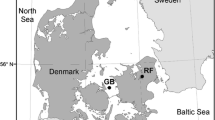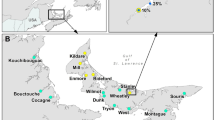Abstract
The distribution of dissolved DNA concentrations and some microbial variables were compared in an oligo-mesotrophic river (the Crystal River) and a phosphate-rich eutrophic river (the Alafia River) in Southwest Florida over a 15 month period. Concentrations of phosphate and nitrate in the Alafia River averaged 135 and 18.2 times the respective phosphate and nitrate concentrations of the oligo-mesotrophic Crystal River. The seasonal average dissolved DNA concentration for the Alafia River exceeded that of the Crystal River by a factor of 1.8 (8.2 μg 1−1 compared to 4.6 μg 1−1, respectively). The greatest concentrations of dissolved DNA in the Alafia River were found in areas that contained the largest populations of phytoplankton and bacteria (a reservoir formed from an abandoned phosphate mining pit and two downstream stations near the mouth of the river). Differences in dissolved DNA concentrations between these environments and more pristine environments (i.e. all Crystal River Stations and upstream Alafia River stations) were of the same order of magnitude (1.8 to 2.2-fold) as the differences in bacterial abundance and activity, but considerably less than differences in phytoplankton abundance and activity between such environments. Seasonal variations in dissolved DNA concentrations in the Crystal River corresponded to seasonal variations in microbial populations, with minimal values in January and greater values in July. In the Alafia River, lowest concentrations for dissolved DNA occurred in July during the wet season, when seasonal flooding of area of leaf litter yielded high levels of dissolved organic carbon (DOC) which were low in dissolved DNA. These results suggest that: 1) in situ planktonic activity is a greater source of dissolved DNA than allochthonous or terrestrial sources of DOC; 2) factors that control the magnitude of heterotrophic bacterial populations are more likely to control dissolved DNA levels than factors regulating autotrophic population activity and abundance; 3) differences in dissolved DNA between eutrophic and oligo-mesotrophic environments are often much smaller than the differences in nutrient concentration between such environments.
Similar content being viewed by others
References
Alberts, J. J., J. W. Bowling & M. Emmons, 1988. Dissolved carbohydrate distribution and dynamics in two southeastern USA reservoirs. Can. J. Fish. aquat Sci. 45: 325–332.
Armstrong, F. A. J., C. R. Sterns & J. D. H. Strickland, 1967. The measurement of upwelling and subsequent biological processes by means of the Technicon Autoanalyzer and associated equipment. Deep Sea. Res. 14: 381–389.
Babenizien, C., 1987. Bacterial utilization of dissolved and particulate photosynthetic products. Limnologica 18: 109–122.
Bendschneider, K. & R. J. Robinson, 1952. A new method for the determination of nitrite in seawater. Mar. Res. 11: 87–96.
Brock, T. D. & J. Clyne, 1984. Significance of algal excretory products for growth of epilimnetic bacteria. Appl. envir. Microbiol. 47: 731–734.
Carpenter, E. J. & L. S. Lively, 1980. Review of estimates of algal growth using 14C-tracer techniques, pp. 161–178. In: P. G. Falkowski. Primary productivity in the sea. Brookhaven Symposium in Biology, No. 31. Plenum Press, N.Y.
Cole, J. J., G. E. Likens & D. L. Strayer, 1982. Photosynthetically produced dissolved organic carbon: an important carbon source for planktonic bacteria. Limnol. Oceanogr. 27: 1080–1090.
David, A. W. & J. H. Paul, 1989. Enumeration and sizing of aquatic bacteria by use of a silicon-intensified target camera linked-image analysis system. J. Microb. Meth. 9: 257–266.
DeFlaun, M. F., J. H. Paul & D. Davis, 1986. Simplified method for dissolved DNA determination in aquatic environments. Appl. envir. Microbiol. 52: 654–659.
DeFlaun, M. F., J. H. Paul & W. H. Jeffrey, 1987. Distribution and molecular weight of dissolved DNA in subtropical estuarine and oceanic environments. Mar. Ecol. Progr. Ser. 38: 65–73.
Flannery,M. S., 1989. Tampa and Sarasota Bays: Watersheds and tributaries. In: E. D. Estevez, ed. Tampa and Sarasota Bays: Issues, resources, status, and management. NOAA estuary of the month seminar no. 7. U.S. Dept. of Commerce.
Fletcher, W. L., J. K. Ogle, J. L. Obery & J. M. Todd, 1987. Water resources data-Florida water year 1986. Volume 3A. Southwest Florida surface water. U.S. Geological Survey Water Data Report F1–86–3A., 397 pp.
Fletcher, W. L., R. K. White, V. T. Coston & J. M. Todd, 1988. Water resources data-Florida water year 1987. Vol. 3A. Southwest Florida surface water. U.S. Geological Survey Water Data Report FL-37–3A, 300 pp.
Fredericks, A. D. & J. M. Sackett, 1970. Organic carbon in the Gulf of Mexico. J. Geophys. Res. 75: 2199–2206.
Fuhrman, J. A. & F. Azam, 1982. Thymidine incorporation as a measure of heterotrophic bacterioplankton production in marine surface waters: evaluation and field results. Mar. Biol. 66: 109–120.
Golterman, H. L. & R. S. Clyme, 1971. Methods for chemical analysis of fresh waters. IBP Handbook No. 8. Blackwell, Oxford. 166 pp.
Grasshoff, K. & J. Johannsen, 1972. A new sensitive and direct method for the automatic determination of ammonia in seawater. J. Cons. Int. Explor. Mer. 34: 516–521.
Hara, T. & S. Ueda, 1981. A study on the mechanism of DNA excretion from P. aeruginosa KYU-1-Effect of mitomycin C on extracellular DNA production. Agric. Biol. Chem. 45: 2457–2461.
Holben, W. E., J. K. Jansson, B. K. Chelm & J. M. Tiedje, 1988. DNA probe method for the detection of specific microorganisms in the soil bacterial community. Appl. envir. Microbiol. 54: 703–711.
Hollibaugh, J. T. & F. Azam, 1983. Microbial degradation of dissolved proteins in seawater. Limnol. Oceanogr. 28: 1104–1116.
Holm-Hansen, O. & B. Riemann, 1978. Chlorophyll a determination: Improvements in methodology. Oikos 30: 438–448.
Jones, G. I. & K. Salnonen, 1985. The importance of bacterial utilization of released phytoplankton photosynthate in two humic forest lakes in southern Finland. Holarct Ecol. 8: 133–140.
Minear, R. A., 1972. Characterization of naturally occurring dissolved organic phosphorus compounds. Envir. Sci. Technol. 6: 431–437.
Murphy, J. & J. P. Riley, 1962. A modified single solution method for the determination of phosphate in natural waters. Analyt. Chim. Acta. 27: 31–36.
Paul, J. H., 1982. Use of Hoechst dyes 33258 and 33342 for enumeration attached and planktonic bacteria. Appl. envir. Microbiol. 43: 939–944.
Paul, J. H. & A. W. David, 1989. Production of extracellular nucleic acids by genetically altered bacteria in aquatic environment microcosms. Appl. envir. Microbiol. 55: 1865–1869.
Paul, J. H., M. F. DeFlaun, W. H. Jeffrey & A. W. David, 1988. Seasonal and diel variability in dissolved DNA and in microbial biomass and activity in a subtropical estuary. Appl. envir. Microbiol. 54: 718–727.
Paul, J. H., W. H. Jeffrey & M. F. DeFlaun, 1987. Dynamics of extracellular DNA in the marine environment. Appl. envir. Microbiol. 53: 170–179.
Paul, J. H. & B. Myers, 1982. Fluorometric determination of DNA in aquatic microorganisms by use of Hoechst 33258. Appl. envir. Microbiol. 43: 1393–1399.
Porter, K. G. & Y. S. Feig, 1980. The use of DAPI for identifying and counting aquatic microflora. Limnol. Oceanogr. 25: 943–948.
Riemann, B. & M. Sondergaard, 1984. Measurements of diel rates of bacterial secondary production of aquatic environments. Appl. envir. Microbiol. 52: 1368–1373.
Rosenau, J. C., G. L. Faulkner, C. W. Hendry & R. W. Hull, 1977. Springs of Florida. State of Florida Department of Natural Resources, Bureau of Geology Bulletin No. 31, 461 pp.
Sondergaard, M. & H. H. Schierup, 1982. Dissolved organic carbon during a spring diatom bloom in Lake Mosso, Denmark. Wat. Res. 16: 815–821.
USGS, 1989. Water Resources Data Florida Water Year 1988. Volume 3A. Southwest Florida surface water. U.S. Geological Survey Water Data Report F1–88–3A. 290 pp.
Zar, J. H., 1974. Biostatistical analysis. Prentice Hall, Inc. Englewood Cliffs, NJ. 620 pp.
Author information
Authors and Affiliations
Rights and permissions
About this article
Cite this article
Paul, J.H., Cazares, L.H., David, A.W. et al. The distribution of dissolved DNA in an oligotrophic and a eutrophic river of Southwest Florida. Hydrobiologia 218, 53–63 (1991). https://doi.org/10.1007/BF00006418
Received:
Revised:
Accepted:
Issue Date:
DOI: https://doi.org/10.1007/BF00006418




